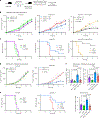The GPCR-Gαs-PKA signaling axis promotes T cell dysfunction and cancer immunotherapy failure
- PMID: 37308665
- PMCID: PMC10735169
- DOI: 10.1038/s41590-023-01529-7
The GPCR-Gαs-PKA signaling axis promotes T cell dysfunction and cancer immunotherapy failure
Abstract
Immune checkpoint blockade (ICB) targeting PD-1 and CTLA-4 has revolutionized cancer treatment. However, many cancers do not respond to ICB, prompting the search for additional strategies to achieve durable responses. G-protein-coupled receptors (GPCRs) are the most intensively studied drug targets but are underexplored in immuno-oncology. Here, we cross-integrated large singe-cell RNA-sequencing datasets from CD8+ T cells covering 19 distinct cancer types and identified an enrichment of Gαs-coupled GPCRs on exhausted CD8+ T cells. These include EP2, EP4, A2AR, β1AR and β2AR, all of which promote T cell dysfunction. We also developed transgenic mice expressing a chemogenetic CD8-restricted Gαs-DREADD to activate CD8-restricted Gαs signaling and show that a Gαs-PKA signaling axis promotes CD8+ T cell dysfunction and immunotherapy failure. These data indicate that Gαs-GPCRs are druggable immune checkpoints that might be targeted to enhance the response to ICB immunotherapies.
© 2023. The Author(s), under exclusive licence to Springer Nature America, Inc.
Conflict of interest statement
Competing interests
J.S.G. reports consulting fees from Domain Pharmaceuticals, Pangea Therapeutics and io9 and is founder of Kadima Pharmaceuticals, unrelated to the current study. R.B. is an employee and shareholder of CellChorus, Inc. J.C. is an employee and shareholder of Pfizer, Inc. V.H.W. is an employee and shareholder of Septerna, Inc. The other authors declare no competing interests.
Figures














Comment in
-
A GPCR checkpoint drives CD8+ T cell dysfunction and immunotherapy failure in mice.Nat Immunol. 2023 Aug;24(8):1232-1233. doi: 10.1038/s41590-023-01567-1. Nat Immunol. 2023. PMID: 37460641 No abstract available.
References
Publication types
MeSH terms
Grants and funding
- 1F31CA250488-01/CA/NCI NIH HHS/United States
- F31 CA250488/CA/NCI NIH HHS/United States
- F31 DE031961/DE/NIDCR NIH HHS/United States
- ZIA BC011764/ImNIH/Intramural NIH HHS/United States
- R01-DK092590/DK/NIDDK NIH HHS/United States
- R01CA247551/CA/NCI NIH HHS/United States
- U24CA220341/CA/NCI NIH HHS/United States
- R01DE026870/DE/NIDCR NIH HHS/United States
- U24 CA248457/CA/NCI NIH HHS/United States
- 1F31DE031961-01/DE/NIDCR NIH HHS/United States
- F31CA257344/CA/NCI NIH HHS/United States
- F32 DE029990/DE/NIDCR NIH HHS/United States
- U24 CA220341/CA/NCI NIH HHS/United States
- F32DE029990-01/DE/NIDCR NIH HHS/United States
- T15LM011271/LM/NLM NIH HHS/United States
- U24CA248457/CA/NCI NIH HHS/United States
- T15 LM011271/LM/NLM NIH HHS/United States
- R01 AR072368/AR/NIAMS NIH HHS/United States
- R01-AR-072368/AR/NIAMS NIH HHS/United States
- T32 GM007752/GM/NIGMS NIH HHS/United States
- U01 DE028227/DE/NIDCR NIH HHS/United States
- R01 CA247551/CA/NCI NIH HHS/United States
- R01 DE026870/DE/NIDCR NIH HHS/United States
- U54 CA209891/CA/NCI NIH HHS/United States
- U54CA209891/IP/NCIRD CDC HHS/United States
- F31 CA257344/CA/NCI NIH HHS/United States
- T32 DK007752/DK/NIDDK NIH HHS/United States
- T32 CA067754/CA/NCI NIH HHS/United States
- R01 DK092590/DK/NIDDK NIH HHS/United States
LinkOut - more resources
Full Text Sources
Other Literature Sources
Medical
Molecular Biology Databases
Research Materials

